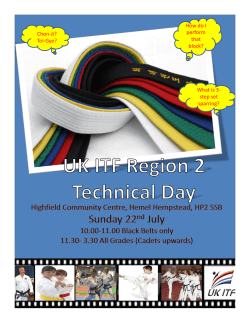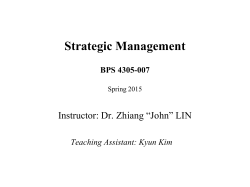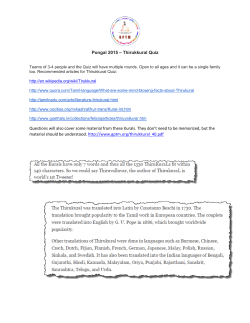
CE 95 greensheet S15 - San Jose State University
San José State University Department of Civil and Environmental Engineering CE 95, Theory and Application of Statics Section 1, Spring 2015 Instructor: Steven Vukazich Office Location: ENG 165 Telephone: 408-924-3858 Email: Steven.Vukazich@sjsu.edu Office Hours: M 0920-1020 TR 0820-0850 or during advising hours (if no advisees are waiting) Class Days/Time: TR 0900 – 1015 Classroom: ENG 189 Prerequisites: MATH 31, PHYS 50 Faculty Web Page and MySJSU Messaging Course materials such as the syllabus and homework solutions can be found on my faculty web page at http://www.engr.sjsu.edu/vukazich/ce_160.htm. You are responsible for regularly checking with the messaging system through MySJSU to learn of any updates or announcements. Course Description Detailed study of bodies in equilibrium to provide background for advanced study of engineering mechanics. Applications to general three-dimensional bodies and structural systems. Topics include free body diagrams, centroids, internal forces, distributed loads, moments of inertia and friction. Course Objectives and Student Learning Outcomes The objectives of the course are to: 1. Introduce the student to the fundamentals of analysis of bodies and structures in static equilibrium; 2. Introduce the student to the concepts of centroid and center of gravity and the mathematical calculations involved in finding the centroid of a two-dimensional area; CE 95 Spring 2015 Page 1 of 10 3. Introduce the student to the concept of moment of inertia and the mathematical calculations involved in finding moments of inertia of two-dimensional areas. Course Content Student Learning Outcomes The learning outcomes listed support course objectives 1 through 3. The course objective and ABET outcome that each learning outcome supports is shown in parenthesis. Upon successful completion of this course, students will be able to: a. Express a vector in terms of components (Objective 1, ABET Outcome A); b. Find the vector and scalar product of vectors (Objective 1, ABET Outcome A). c. Draw Free Body diagrams (F.B.D.) of two and three-dimensional structures, or their components, with all loads and reactions correctly applied (Objective 1, ABET Outcome A); d. Express forces on two- and three-dimensional bodies in terms of an equivalent force and couple system (Objective 1, ABET Outcome A); e. Analyze truss structures using the method of joints and method of sections; (Objective 1, ABET Outcome A); f. Analyze frames and machines (Objective 1, ABET Outcome A);; g. Find shear and bending moment forces in beams (Objective 1, ABET Outcome A); h. Analyze simple structures acted on by friction (Objective 1, ABET Outcome A); i. Find centroids and centers of gravity of two-dimensional bodies by integration (Objective 2, ABET Outcomes A); j. Find centroids and centers of gravity of two-dimensional composite bodies (Objective 2, ABET Outcome A); k. Calculate moments of inertia of various shapes by integration (Objective 3, ABET Outcome A); l. Calculate moments of inertia of composite shapes using the parallel axis theorem (Objective 3, ABET Outcome A); Required Texts/Readings Textbook Beer and Johnston, “Statics and Mechanics of Materials” (SJSU custom text for CE 95 with Connect package), ISBN: 9780073380155 Course Requirements and Assignments SJSU classes are designed such that in order to be successful, it is expected that students will spend a minimum of forty-five hours for each unit of credit (normally three hours per unit per week), including preparing for class, participating in course activities, CE 95 Spring 2015 Page 2 of 10 completing assignments, and so on. More details about student workload can be found in University Policy S12-3 at http://www.sjsu.edu/senate/docs/S12-3.pdf. Exams: The final exam will be Open-Book, Closed-Notes. One standard 3 inch by 5 inch index card (front and back) is allowed for the final exam. Bring a calculator, pencil, and eraser for the final exam. Please do not use pens on the final exam. No phones or electronic devices will be allowed to be used during the final exam. All phones and electronic devices must be switched off and put away during the final exam. Instructor permission is required to leave the classroom for bathroom visits or other reasons during the final exam. The Final Exam must be completed in order to complete the course. Quizzes: Five 20-minute Closed-Book and Closed-Notes quizzes will be held at the end of the class period on the dates indicated on the schedule. Bring a calculator, pencil, and eraser for quizzes. Please do not use pens on quizzes. The best 4 out of 5 quizzes will be counted toward the course grade. No make-up quizzes will be given: a missed quiz will be excused for valid reasons per SJSU policy (reported in advance if possible). If more than one quiz is missed for valid reasons, the course grade will be based on the remaining course work. Homework: A list of homework problems for the material covered in each chapter is given on the last page of this syllabus. Homework will not be collected and graded but its timely completion and understanding is essential for learning the material and performing well on the exams. In order to guide the timely completion of homework, the problems that are appropriate for the material covered are designated in the table below. Note that homework problems might be added or deleted from the list as the semester progresses. Topic [Text Section] Recommended Homework Problems Vector Operations, Force Vectors, Force Systems, Vector Addition, Scalar Components [2.1-2.8] 2.24, 2.26, 2.29 2-D Equilibrium of a Particle, Free Body Diagram (F.B.D.) [2.9-2.11] 2.34, 2.39. 2.47 Forces in 3-D space, Scalar Components [2.12-2.14] Equilibrium of a Particle in Space [2.15] Forces on Rigid Bodies, Vector (Cross) Product, Moment of a Force about a Point [3.1-3.8] 2.63, 2.69, 2.73 2.83, 2.87 3.1, 3.4, 3.8, 3.11, 3.13, 3.16, 3.22 CE 95 Spring 2015 Page 3 of 10 Topic [Text Section] Recommended Homework Problems Scalar (Dot) Product, Moment of a Force about an Axis [3.9, 3.11] Moment of a Couple, Reduction of Force Systems [3.12-3.16] Equivalent Force Systems [3.17-3.18], 3.25, 3.29 2-D Supports, F.B.D., 2-D Equilibrium, Solution of Equations of Equilibrium for 2-D Rigid Bodies [4.1-4.4] Equilibrium of 2 and 3 Force Bodies [4.6-4.7] Trusses - Method of Joints [6.1-6.5] 4.2, 4.7, 4.11, 4.12, 4.17 4.27, 4.30, 4.44 6.2, 6.7, 6.10 Trusses - Method of Sections [6.6] Frames [6.8-6.10] 6.25, 6.27, 6.33 6.49, 6.52, 6.60 Machines [6.11] 6.85 Dry Friction [4.10-4.13] Centroids, Center of Gravity of a 2-D Body, Centroids of Composite Bodies [5.1-5.3], Finding Centroids using Integration [5.4, 5.6], Distributed Loads [5.8] Moment of Inertia (MOI) using Integration [7.1-7.3] Moment of Inertia (MOI), Radius of Gyration, ParallelAxis Theorem, MOI of Composite Areas [7.4-7.7] Internal Forces [12.1-12.2] General 3-D Equilibrium [4.8-4.9] 4.75, 4.79, 4.91, 4.95 5.1, 5.3, 5.6, 3.50. 3.51, 3.61, 3.64 3.73 5.26 5.51, 5.54, 5.55 7.9, 7.13 7.26, 7.27, 7.30, 7.31 12.1, 12.2, 12.6 4.59 It is the responsibility of the individual student to verify, in detail, the correctness of the final results, calculations, diagrams, and solution methodology for each homework problem. For this purpose, homework solutions are available on the course website: http://www.engr.sjsu.edu/vukazich/ce_160.htm. Classroom Protocol Please make every effort to arrive on time: turn off and put away cell phones, laptop computers, and any other electronic devices during class. Instructor permission is required for use of laptop computers and other electronic devices during class. If you do happen to arrive to class late, please enter and take your seat quietly. CE 95 Spring 2015 Page 4 of 10 Office Hours Phone and email communication is most appropriate for administrative matters (notification of illness, scheduling appointments, clarification of homework problems, etc.). Because of the extensive use of Free Body Diagrams and figures, detailed solution strategy to homework problems or other course material is best discussed in person during scheduled office hours and not via phone or email. NOTE that University policy F69-24 at http://www.sjsu.edu/senate/docs/F69-24.pdf states that “Students should attend all meetings of their classes, not only because they are responsible for material discussed therein, but because active participation is frequently essential to insure maximum benefit for all members of the class. Attendance per se shall not be used as a criterion for grading.” Grading Policy Grades are assigned based on class performance on the quizzes and the final exam with the weights listed below: Best 4 of 5 Quizzes (15% each) 60% Final Exam 40% Course grades are assigned based on a total of 100 points possible for the course with standard decimal rounding (i.e. 0.5 and greater rounded up). If the median score on any individual quiz is less than 70%, all scores will be adjusted to bring the median score on that particular quiz to 70%. For example, if the class median score on quiz 1 is 67/100, 3 points will be added to the score of each quiz to bring the median to 70/100. The final course grades will be assigned according to the following grading scale: > 98 A+ 91-97 A 88-90 A85-87 B+ 75-84 B 72-74 B69-71 C+ 59-68 C 56-58 C53-55 D+ 43-52 D 40-41 D< 39 F CE 95 Spring 2015 Page 5 of 10 CEE Policy Statement on Enforcement of Prerequisites/Co-requisites for Undergraduate Courses All undergraduate students must hand in the following documents (as appropriate) to the class instructor at the beginning of the third class meeting: 1. 2. 3. 4. 5. A transcript (unofficial) showing that the student has the prerequisites and corequisites for the course with the required grade. A copy of the assist.org document showing the equivalency for any prerequisite or co-requisite if the course was taken at another university or a community college. A signed equivalency form, if the prerequisite or co-requisite was taken at a college for which an assist.org document is not available. A copy of the student’s official schedule for the current semester indicating enrollment in a co-requisite course if the student is concurrently enrolled in a corequisite. For courses that require junior and/or senior standing, the instructor will check the class roster to verify the required standing. Students who do not meet the prerequisites or co-requisites will be dropped from the course. Students who are enrolled in the class at the beginning of the semester and fail to produce the appropriate documents by the beginning of the third class meeting will be dropped from the course. Students who were not enrolled in the class at the beginning of the semester will produce the required document(s) by the beginning of the third class meeting after enrolling in the course. Such students, who fail to produce the appropriate document(s) by the beginning of the third class meeting after enrolling in the course, will be dropped from the course. The package you will need to turn in for CE 95 on or before the third class meeting (January 29, 2015) is: Math 31 • Taken at SJSU – SJSU unofficial transcript; • Taken at California Community College – Assist.org printout(s) and unofficial transcript(s) showing course equivalency to Math 31; • Taken at other colleges - Signed Equivalency form and unofficial transcript. Phys 50 • Taken at SJSU – SJSU unofficial transcript; • Taken at California Community College – Assist.org printout(s) and unofficial transcript(s) showing course equivalency to Phys 50; • Taken at other colleges - Signed Equivalency form and unofficial transcript. University Policies General Expectations, Rights and Responsibilities of the Student As members of the academic community, students accept both the rights and responsibilities incumbent upon all members of the institution. Students are encouraged to familiarize themselves with SJSU’s policies and practices pertaining to the procedures to follow if and when questions or concerns about a class arises. See University Policy CE 95 Spring 2015 Page 6 of 10 S90–5 at http://www.sjsu.edu/senate/docs/S90-5.pdf. More detailed information on a variety of related topics is available in the SJSU catalog, at http://info.sjsu.edu/webdbgen/narr/catalog/rec-12234.12506.html. In general, it is recommended that students begin by seeking clarification or discussing concerns with their instructor. If such conversation is not possible, or if it does not serve to address the issue, it is recommended that the student contact the Department Chair as a next step. Dropping and Adding Students are responsible for understanding the policies and procedures about add/drop, grade forgiveness, etc. Refer to the current semester’s Catalog Policies section at http://info.sjsu.edu/static/catalog/policies.html. Add/drop deadlines can be found on the current academic year calendars document on the Academic Calendars webpage at http://www.sjsu.edu/provost/services/academic_calendars/. The Late Drop Policy is available at http://www.sjsu.edu/aars/policies/latedrops/policy/. Students should be aware of the current deadlines and penalties for dropping classes. Information about the latest changes and news is available at the Advising Hub at http://www.sjsu.edu/advising/. Consent for Recording of Class and Public Sharing of Instructor Material University Policy S12-7, http://www.sjsu.edu/senate/docs/S12-7.pdf, requires students to obtain instructor’s permission to record the course and the following items to be included in the syllabus: • “Common courtesy and professional behavior dictate that you notify someone when you are recording him/her. You must obtain the instructor’s permission to make audio or video recordings in this class. Such permission allows the recordings to be used for your private, study purposes only. The recordings are the intellectual property of the instructor; you have not been given any rights to reproduce or distribute the material.” • “Course material developed by the instructor is the intellectual property of the instructor and cannot be shared publicly without his/her approval. You may not publicly share or upload instructor generated material for this course such as exam questions, lecture notes, or homework solutions without instructor consent.” Academic integrity Your commitment, as a student, to learning is evidenced by your enrollment at San Jose State University. The University Academic Integrity Policy S07-2 at http://www.sjsu.edu/senate/docs/S07-2.pdf requires you to be honest in all your academic course work. Faculty members are required to report all infractions to the office of Student Conduct and Ethical Development. The Student Conduct and Ethical Development website is available at http://www.sjsu.edu/studentconduct/. Campus Policy in Compliance with the American Disabilities Act If you need course adaptations or accommodations because of a disability, or if you need to make special arrangements in case the building must be evacuated, please make an appointment with me as soon as possible, or see me during office hours. Presidential Directive 97-03 at http://www.sjsu.edu/president/docs/directives/PD_1997-03.pdf requires that students with disabilities requesting accommodations must register with the CE 95 Spring 2015 Page 7 of 10 Accessible Education Center (AEC) at http://www.sjsu.edu/aec to establish a record of their disability. SJSU Counseling Services The SJSU Counseling Services is located on the corner of 7th Street and San Fernando Street, in Room 201, Administration Building. Professional psychologists, social workers, and counselors are available to provide consultations on issues of student mental health, campus climate or psychological and academic issues on an individual, couple, or group basis. To schedule an appointment or learn more information, visit Counseling Services website at http://www.sjsu.edu/counseling. CE 95 Spring 2015 Page 8 of 10 CE 95, Theory and Application of Statics, Spring 2014 Lecture, Exam, and Quiz Schedule Note that the schedule below is subject to change with advance notice given in class. Week Date Lecture Topics (tentative) and Text Reading 1 1/22 1/27 1/29 Introduction, Vector Operations, Force Vectors [2.1-2.3] Force Systems, Vector Addition, Scalar Components [2.4-2.8] 2-D Equil. of a Particle, Free Body Diagram (F.B.D.) [2.9-2.11] Prerequisite documents due 2/3 2/5 2/10 2/12 2/17 2/19 2/24 2/26 3/3 3/5 3/10 3/12 2-D Equil. of a Particle, Free Body Diagram (F.B.D.) [2.9-2.11] Forces in 3-D space, Scalar Components [2.12-2.14] Equilibrium of a Particle in Space [2.15] Forces on Rigid Bodies, Vector (Cross) Product [3.1-3.5], Quiz 1 Moment of a Force about a Point [3.6-3.8] Scalar (Dot) Product, Moment of a Force about an axis [3.9, 3.11] Moment of a Couple, Reduction of Force Systems [3.12-3.16] Equivalent Force Systems [3.17-3.18] 2-D Supports, F.B.D., 2-D Equilibrium [4.1-4.4] Solution. of Equations of Equil. for 2-D Rigid Bodies [4.4], Quiz 2 Equilibrium of 2 and 3 Force Bodies, Review [4.6-4.7] Trusses - Method of Joints, Zero Force Members [6.1-6.5] 3/17 3/19 Trusses - Method of Sections [6.6] Frames [6.8-6.10] Frames [6.8-6.10], Quiz 3 3/25 3/27 Spring Recess 10 3/31 4/2 Caesar Chavez Holiday Frames [6.8-6.10] 11 4/7 4/9 Machines [6.11] Dry Friction [4.10-4.12], Dry Friction Problems [4.13] 12 4/14 4/16 Centroids, Center of Gravity of a 2-D Body [5.1-5.3] Centroids of Composite Bodies, Integration [5.4-5.6], Quiz 4 13 4/21 4/23 Distributed Loads [5.8] Moment of Inertia (MOI), Radius of Gyration [7.1-7.5] 14 4/28 4/30 Parallel-Axis Theorem, MOI of Composite Areas [7.6-7.7] Parallel-Axis Theorem, MOI of Composite Areas [7.6-7.7], Quiz 5 2 3 4 5 6 7 8 9 CE 95 Spring 2015 Page 9 of 10 Week 15 16 Final Exam Date Lecture Topics (tentative) and Text Reading 5/5 5/7 5/12 Internal Forces [12.1-12.2] Internal Forces [12.1-12.2], 3-D Equilibrium [4.8-4.9] 3-D Equilibrium [4.8-4.9], Review 5/21 0715 – 0930 (time and date per SJSU Spring 2015 Final Exam Schedule) CE 95 Spring 2015 Page 10 of 10
© Copyright 2025













